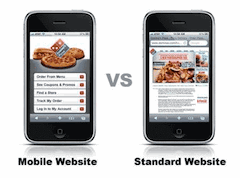10 Signs Your Site is Not Mobile Friendly
March 10, 2012 | in longhorn
 The percentage of people who may access your website through mobile devices is growing every day. If your website was designed to be accessed only by traditional online computers, you may not be keeping up with technology and lose traffic to your site. This is something most people don’t even think about while they wonder why their web hits have declined. How do you know if your website is mobile friendly? By using website analytics and other methods you can determine if you need to make some changes. Here are 10 signs your site is not mobile friendly.
The percentage of people who may access your website through mobile devices is growing every day. If your website was designed to be accessed only by traditional online computers, you may not be keeping up with technology and lose traffic to your site. This is something most people don’t even think about while they wonder why their web hits have declined. How do you know if your website is mobile friendly? By using website analytics and other methods you can determine if you need to make some changes. Here are 10 signs your site is not mobile friendly.
- Bounce rate – Use your analytics to determine your bounce rate. This is the percentage of times people visit your site and leave after viewing only one page. This could tell you that people with mobile devices weren’t able to navigate properly, got frustrated and left.
- Traffic conversion – Another analytic tool is to check your traffic conversion. Are there lots of visitors to your site who are unable to complete transactions? Your website may be making it difficult for mobile users to finish complex processes.
- Too many clicks – How many clicks does it take to navigate your site, find what they need or complete transactions? This can be very cumbersome to people on their smartphones or blackberries. Limiting the clicks can make your site more mobile friendly.
- Complex content – Websites with all the bells and whistles are not impressive to people on their mobile phones. The site takes to long to load and is hard to read on the miniature screen. Simplicity is better when it comes to being mobile friendly.
- Navigation capabilities – The location of your website navigation tools is important to mobile users. They prefer them at the top or bottom so they don’t obstruct the main page. Put them at the bottom so they don’t get in the way of reading the page or use drop down menus at the top.
- Not designed for touchscreen – If your links or navigation tools are placed too close together, that makes it difficult for touchscreen users. Make sure there’s plenty of space for big fingers on tiny screens.
- Clean semantic markup – Your content needs to be well structured with clear organization and semantic markup so it will display cleanly and be usable by any mobile device. Without this your content may turn out garbled or unreadable.
- Inflexible page layout – Your page layouts need to be flexible enough to fit any size screen from a flat monitor to an iPad or to a mobile phone. Mobile users will get frustrated with your site in a hurry if it doesn’t fit their screen properly.
- Non-scalable images and media – The same thing goes for scalable images and media you include on your site. This attention to detail will make your site much more attractive to mobile device users.
- People tell you – The best way to know if your site is not mobile friendly is when people tell you. If your friends or even strangers call you up to tell you your site doesn’t work on their device, it’s a good idea to listen. Pay attention to what they have to say and take steps to correct the problem.
If you’re getting any of these signs your site isn’t mobile friendly, you should immediately check it out. One way to do that is to test it with your own mobile device. Many people never think to check out their own website, but that’s a big mistake. Since there’s no way for you to do this with every mobile device available there are online applications that can do this for you. Traffic is key to any website’s success. Keeping up with mobile device technology will make sure you’re not losing important hits to your site.
← 10 Reasons Most Social Bookmarking Sites Suck | 10 Reasons to Privacy Protect Your Domain →Comments are closed.
Recent Articles
- 10 of the Best iPhone App Dictionaries
- 10 Voice Altering iPhone Apps
- 10 iPhone Apps That Will Help You Draft Your Fantasy Football Team
- 10 of the Best iPhone Apps For Monitoring Your Stock Options
- 7 Caffeine Substitutes for a Healthy Jump-Start
- 10 Best Free iPhone Apps of All Time
- 10 iPhone Apps That Could Save Your Life
- 30 Blogs with the Best Tips For Getting a Better Internet Connection
- How Not to Get Addicted to Social Media
- 20 Things to Think Twice About Before Including Them On Your Blog
Categories
Archives
- September 2013
- August 2013
- July 2013
- June 2013
- May 2013
- April 2013
- March 2013
- February 2013
- January 2013
- November 2012
- October 2012
- September 2012
- August 2012
- July 2012
- June 2012
- May 2012
- April 2012
- March 2012
- February 2012
- January 2012
- December 2011
- November 2011
- October 2011
- September 2011
- August 2011
- July 2011
- June 2011
- April 2011
- March 2011
- February 2011
- January 2011
- December 2010
- November 2010
- August 2010


